International Journal of Epidemiology And Public Health Research
OPEN ACCESS | Volume 7 - Issue 5 - 2025
ISSN No: 2836-2810 | Journal DOI: 10.61148/2836-2810/IJEPHR
Meikun Liu 1, Tiesheng Han 1*
1School of Public Health, North China University of Science and Technology, Tangshan 063210, China.
*Corresponding author: Tiesheng Han, School of Public Health, North China University of Science and Technology, Tangshan 063210, China.
Received: April 08, 2025
Accepted: May 15, 2025
Published: May 19, 2025
Citation: Liu M, Han T. (2025) “Trend Analysis and Prediction of Syphilis Incidence and Mortality in China from 1992 to 2021”. International Journal of Epidemiology and Public Health Research, 6(4); DOI: 10.61148/2836- 2810/IJEPHR/133.
Copyright: © 2025. Tiesheng Han. This is an open access article distributed under the Creative Commons Attribution License, which permits unrestricted use, distribution, and reproduction in any medium, provided the original work is properly cited., provided the original work is properly cited.
Background/Objectives: To analyze the incidence and mortality trend of syphilis in China from 1992 to 2021, and to evaluate the impact of age, period and birth cohort factors on the incidence and mortality of syphilis, so as to provide reference for the targeted prevention and control management of syphilis and the rational allocation of health resources. Methods: The incidence and mortality data of syphilis in China from 1992 to 2021 in the Global Burden of Disease 2021 (GBD 2021) database. were collected. The age-standardized incidence rate (ASIR) and age-standardized mortality rate (ASMR) of syphilis from 1992 to 2021 were described by the joint point regression model. The age-period-cohort (APC) model was used to analyze the effects of age, period and birth cohort factors on the incidence and mortality of syphilis. The Nordpred model was used to predict the incidence and mortality of syphilis in 2022-2046. Results: Compared with 1992, the overall incidence of syphilis in 2021 increased by 0.93%, the number of males decreased by 1.57%, and the number of females increased by 11.81%. During the same period, the overall ASIR and ASMR decreased by 0.95% and 12.50%, respectively. The ASIR of males decreased by 3.93%, and the ASIR of females increased by 10.81%. The regression analysis of the coupling points showed that the ASIR and ASMR of syphilis in China showed an upward-downward-upward trend from 1992 to 2021. The age effect of the APC model showed that the risk of syphilis in both men and women showed an inverted U-shaped curve, with peaks at 25-29 years old and 20-24 years old, respectively. The risk of death increased with age. The period effect showed that the risk of syphilis in men increased with the passage of time, while that in women increased first and then decreased with the passage of time. The risk of death for both men and women decreased over time. The birth cohort effect showed that the later the birth, the lower the risk of syphilis incidence and death. The results of Nordpred model showed that the number of syphilis cases, deaths and age-standardized rates showed a downward trend from 2022 to 2046. Conclusions: From 1992 to 2021, the overall incidence and mortality of syphilis in China showed an upward-downward-upward trend. The risk of syphilis incidence and death was affected by age, period and birth cohort factors. Young people, especially men, were the main group of syphilis incidence. The risk of syphilis death in the elderly population was high. Syphilis screening and treatment should be strengthened to reduce the risk of death.
1. Introduction
Syphilis is a chronic systemic disease caused by Treponema pallidum infection [1]. It is mainly transmitted through sexual contact [2], which is extremely harmful. It not only affects the urogenital system, but also damages the nervous system, cardiovascular system, eye system, liver system and so on [3]. Globally, more than 5 million new cases of syphilis are reported each year [4]. The number of cases is high, the disease is serious, the affected population is wide, and the difference between different regions is obvious [5]. Syphilis has become a common public health problem, which seriously endangers human physical and mental health [6]. The syphilis epidemic cannot be ignored. Based on the Global Burden of Disease 2021 (GBD 2021) database, this study systematically analyzed the trend characteristics of syphilis incidence and mortality in China from 1992 to 2021. Through the age-period-cohort model (APC) model, the effects of age, period and birth cohort on the incidence and mortality of syphilis were analyzed in depth, and the incidence and mortality of syphilis from 2022 to 2046 were predicted, aiming to provide reference for the formulation and optimization of syphilis prevention and control policies.
2. Materials and Methods
2.1 Data Source
The research data are derived from the Global Burden of Disease 2021 (GBD 2021) database. This research project was established by the Institute for Health Metrics and Evaluation (IHME) at the University of Washington in the United States. The database covers 371 diseases [7] and 88 risk factors [8] attributable burden of disease data in 204 countries and regions and 811 national subregions. The database integrates a wide range of data sources, including national health surveys, scientific literature, epidemiological data, disease registration data, etc. [9]. redistributes garbage codes and unclear codes in different source data, and corrects issues such as underreporting, incompleteness, and misclassification [10]. The data is reliable. Data on the number of syphilis cases, deaths and their corresponding age-standardized rates in China from 1992 to 2021 were ob-tained from the database.
2.2 Research Method
2.2.1 Time trend analysis The trend of age-standardized incidence rate (ASIR) and age-standardized mortality rate (ASMR) of syphilis in China from 1992 to 2021 was an-alyzed by using the connection point regression model, and the annual percent change (APC) was calculated to evaluate the internal trend of each year. Joinpoint 4.9.1.0 soft-ware can be used to analyze the joint point regression model. ASIR and ASMR were used as dependent variables, year as independent variable and gender as grouping variable to construct the regression model of the connection point. The Monte Carlo permutation test method was used to select the model. The significance level was 0.05, the number of permutations was 4499, 30 data points, and the maximum connection point was 5. If APC > 0, the incidence or mortality rate showed an upward trend; if APC < 0, the incidence / mortality rate showed a downward trend.
2.2.2 Analysis of age-period-cohort model Age-period-cohort (APC) model was used to evaluate the effects of age, period and birth cohort factors on the incidence and mortality of syphilis. The model requires age, period, and cohort spacing to be con-sistent. Referring to previous studies [11], this study used a continuous 5-year-old age group as an age group and every 5 years as a period or cohort group. Due to the collin-earity problem among age, period and cohort, the model was solved by the endogenous factor (Intrinsic Estimator, IE) method (Yang et al. [12]), and the APC model was fitted. The effect coefficients of age, period and birth cohort of syphilis incidence and death were obtained. Relative Risk (RR) = EXP (effect coefficient) [13] represents the risk of incidence and death of specific age, period and birth cohort relative to the average level.
2.2.3 Syphilis morbidity and mortality prediction The Nordpred model is a long-term prediction model based on the age-period-cohort analysis model [14]. The deviation between the predicted value and the observed value can be reduced by con-sidering the change of morbidity or mortality and the dynamic population structure, and the result is more accurate. It is widely used in disease prediction [15,16]. The model expression is :








2.3 statistical analysis
In this study, R language (version 4.3.3) was used to complete data cleaning and format conversion. Joinpoint 4.9.1.0 software was used to analyze the change trend of syphilis ASIR and ASMR. The APC model was fitted by Stata16.0 software, and the test level was α = 0.05. R package Nordpred was used to predict the incidence and mortality of syphilis. R package tidyverse, ggplot2, etc. were used for data collation and visualization.
3. Results
3.1. Comparison of syphilis incidence and mortality between 1992 and 2021
The number of syphilis cases increased from 2.0284 million in 1992 to 2.0472 million in 2021, representing an increase of 0.93 %. The ASIR (Age-Standardized Incidence Rate) decreased from 147.80 per 100,000 to 146.40 per 100,000, and the crude incidence rate decreased from 168.10 per 100,000 to 143.80 per 100,000, with decreases of 0.95 % and 14.46 %, respectively. In the same period, the number of syphilis deaths decreased by 51.22 %, the crude mortality rate decreased from 0.34 per 100,000 to 0.14 per 100,000 (a decrease of 58.82 %), and the ASMR (Age-Standardized Mortality Rate) decreased from 0.40 per 100,000 to 0.35 per 100,000 (a decrease of 12.50 %). However, there were gender differences. In 2021, the incidence and mortality indicators of males were lower than those in 1992, and the incidence and ASIR of females were higher than those in 1992. See Table 1.
Table 1: Comparison of syphilis incidence and mortality in China between 1992 and 2021
|
Index |
The whole crowd |
Male |
Female |
||||||
|
In |
In |
Change rate ( % ) |
In |
In |
Change rate ( % ) |
In |
In |
Change rate ( % ) |
|
|
Number of cases |
202.84 |
204.72 |
0.93 |
164.99 |
162.40 |
-1.57 |
37.85 |
42.32 |
11.81 |
|
Crude incidence |
168.10 |
143.80 |
-14.46 |
264.74 |
223.05 |
-15.75 |
64.92 |
60.93 |
-6.15 |
|
Standardized morbidity |
147.80 |
146.40 |
-0.95 |
231.03 |
221.94 |
-3.93 |
58.21 |
64.50 |
10.81 |
|
death count |
0.41 |
0.20 |
-51.22 |
0.22 |
0.11 |
-50.00 |
0.18 |
0.09 |
-50.00 |
|
crude death rate |
0.34 |
0.14 |
-58.82 |
0.36 |
0.15 |
-58.33 |
0.31 |
0.13 |
-58.06 |
|
standard death |
0.40 |
0.35 |
-12.50 |
0.42 |
0.36 |
-14.29 |
0.39 |
0.34 |
-12.82 |
Note: Change rate = (2021 value-1992 value) / 1992 value × 100 %
3.2 Trends in incidence and mortality of syphilis in China from 1992 to 2021
3.2.1. Trend of Syphilis Incidence
The ASIR of syphilis in China showed an upward-downward-upward trend from 1992 to 2021. It can be divided into three stages. From 1995 to 2000, it showed a rapid upward trend, with an APC of 2.54 %. From 2008 to 2019, it turned into a downward trend, with an APC of -1.76 % (P < 0.05). From 2019 to 2021, it showed an upward trend, with the APC reaching 3.59 % (P < 0.05). The trend of the ASIR for male syphilis was divided into three stages. It decreased slightly from 1992 to 1995 (APC = −0.21%, P < 0.05), and then increased from 1995 to 2011. It increased rapidly from 1995 to 2000 (APC = 2.10%, P < 0.05), and the growth rate slowed down from 2000 to 2011 (APC = 0.04%, P < 0.05). There was a turning point in 2011. From 2011 to 2018, it showed a downward trend, and the decline was the fastest from 2011 to 2014 (APC = -3.27%, P < 0.05). The change of the ASIR for female syphilis was also divided into three stages. There was an upward trend from 1992 to 2003 and a significant decline from 2003 to 2019 (APC = −2.85%, P < 0.05). From 2019 to 2021, it increased again, with the APC reaching 11.74% (P < 0.05). See Table 2 and Figure 1.
Table 2: Trend of standardized incidence of syphilis in China from 1992 to 2021
|
Sexuality |
Particular year |
APC(%) |
95% CI |
t value |
P value |
|
population |
1992-1995 |
-0.26 |
-1.20~0.69 |
-0.58 |
0.567 |
|
1995-2000 |
2.54 |
1.93~3.15 |
8.96 |
< 0.001 |
|
|
2000-2008 |
-0.15 |
-0.4~0.09 |
-1.33 |
0.203 |
|
|
2008-2019 |
-1.76 |
-1.9~-1.62 |
-26.29 |
< 0.001 |
|
|
2019-2021 |
3.59 |
1.70~5.51 |
4.07 |
0.001 |
|
|
male |
1992-1995 |
-0.21 |
-0.34~-0.08 |
-3.55 |
0.004 |
|
1995-2000 |
2.10 |
2.02~2.18 |
54.87 |
< 0.001 |
|
|
2000-2011 |
0.04 |
0.02~0.06 |
3.79 |
0.002 |
|
|
2011-2014 |
-3.27 |
-3.51~-3.02 |
-28.35 |
< 0.001 |
|
|
2014-2018 |
-1.10 |
-1.22~-0.97 |
-18.90 |
< 0.001 |
|
|
2018-2021 |
0.05 |
-0.08~0.17 |
0.84 |
0.418 |
|
|
female |
1992-2003 |
2.80 |
2.3~3.31 |
11.68 |
< 0.001 |
|
2003-2019 |
-2.85 |
-3.14~-2.55 |
-19.73 |
< 0.001 |
|
|
2019-2021 |
11.74 |
3.76~20.33 |
3.11 |
0.005 |
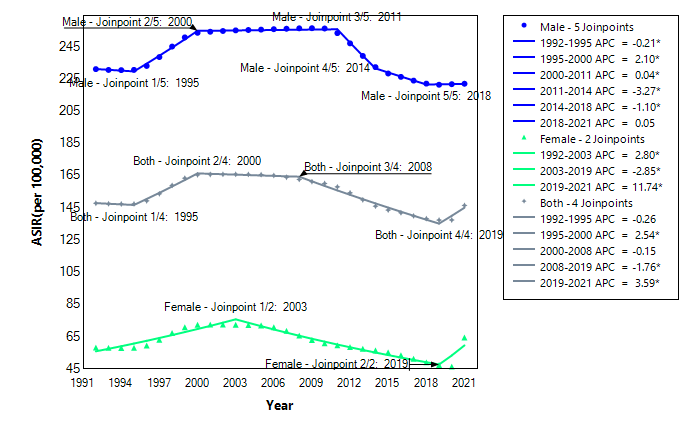
Note:* indicates P <0.05
Figure 1 Trend of standardized incidence of syphilis in China Joinpoint chart
3.2.2 Trend analysis of syphilis mortality
The ASMR of syphilis in China showed an overall upward-downward-upward trend from 1992 to 2021, with two turning points, including an upward trend from 1992 to 2002 (APC = 1.49 %, P < 0.05), a downward trend from 2002 to 2019 (APC = -4.18 %, P < 0.05), and an upward trend from 2019 to 2021 (APC = 21.03 %, P < 0.05). Male and female changes are consistent with the overall. The ASMR of males showed an upward trend from 1992 to 2002, a downward trend from 2002 to 2019 (APC= -4.11 %, P < 0.05 ), and an upward trend from 2019 to 2021 (APC= 20.41 %, P < 0.05). For women, 1992-2001 was the rising period (APC= 2.22 %, P < 0.05), 2001-2019 was the declining period (APC= − 4.10 %, P < 0.05), and 2019-2021 was the rising period (APC = 20.92 %, P < 0.05). See Table 3 and Figure 2.
Table 3: Trend of standardized mortality of syphilis in China from 1992 to 2021
|
Sexuality |
Particular year |
APC(%) |
95%CI |
t value |
P value |
|
population |
1992-2002 |
1.49 |
0.48~2.51 |
3.07 |
0.006 |
|
|
2002-2019 |
-4.18 |
-4.66~-3.69 |
-17.48 |
<0.001 |
|
|
2019-2021 |
21.03 |
5.42~38.96 |
2.87 |
0.009 |
|
male |
1992-2002 |
1.33 |
0.33~2.35 |
2.76 |
0.011 |
|
|
2002-2019 |
-4.11 |
-4.59~-3.63 |
-17.25 |
<0.001 |
|
|
2019-2021 |
20.41 |
5.16~37.88 |
2.84 |
0.009 |
|
female |
1992-2001 |
2.22 |
1.03~3.42 |
3.89 |
0.001 |
|
|
2001-2019 |
-4.10 |
-4.53~-3.66 |
-19.01 |
<0.001 |
|
|
2019-2021 |
20.92 |
5.33~38.81 |
2.85 |
0.009 |
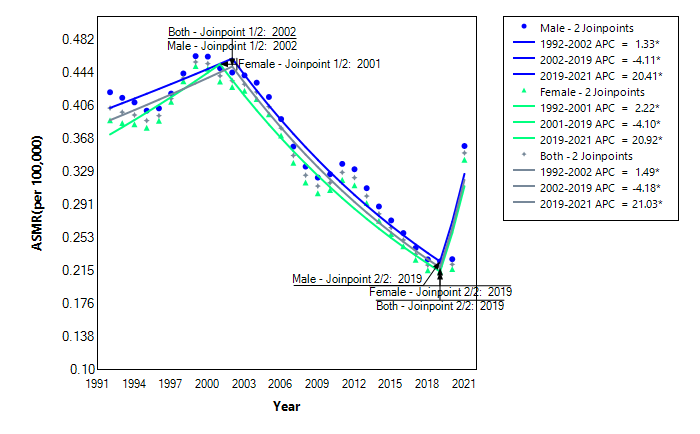
Note:* indicates P <0.05
Figure 2: Trends in the standardized mortality of syphilis in China Joinpoint chart
3.3 APC model analysis of syphilis incidence and mortality in China
3.3.1 Age effect
The age distribution of syphilis risk in men and women showed an inverted U-shaped curve, both of which began to rise rapidly from 15 to 19 years old (RR > 1), and men peaked at 25-29 years old (RR = 5.664,95 % CI: 5.610-5.718), which was 466.4 % higher than the average risk. Women peaked at 20-24 years old (RR = 4.070,95 % CI: 4.019-4.121), 307 % higher than the average risk. The risk of male and female decreased significantly after 55 years old (RR < 1), and reached the lowest value in 60-64 years old. See Figure 3A. The risk of syphilis death in men and women increased with age. Among them, the risk of death in 30-64 years old was always lower than the average risk (RR < 1), began to rise rapidly in 85-89 years old, and peaked in 90-94 years old. See Figure 3B.
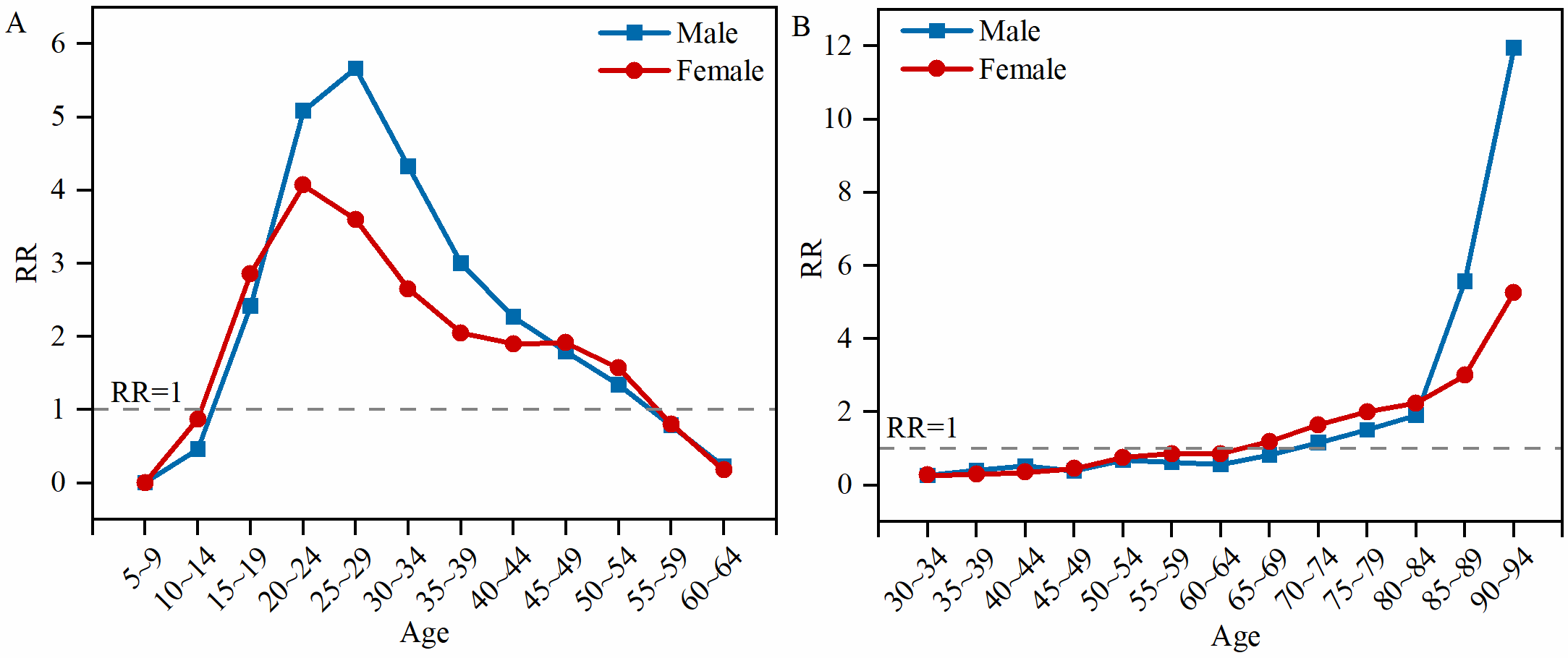
Figure 3: (A) Age effect of syphilis incidence in China from 1992 to 2021. (B) Age effect of syphilis mortality in China from 1992 to 2021
3.3.2 Period effect
The risk of syphilis in men increased over time, with the lowest risk in 1992 ~ 1996 (RR = 0.759,95 % CI: 0.757 ~ 0.762). The risk began to be higher than the average risk from 2002 to 2006 (RR = 1.007), and peaked from 2017 to 2021 (RR = 1.170,95 % CI: 1.166-1.174). The risk of syphilis in women increased first and then decreased. The risk of syphilis was the lowest from 1992 to 1996 (RR = 0.809,95 % CI: 0.805-0.813), and the risk of syphilis peaked from 2002 to 2006 (RR = 1.122,95 % CI: 1.119-1.126), which was 12.2 % higher than the average risk. The risk began to decline from 2007 to 2011, and the risk was the lowest from 2017 to 2021 (RR = 1.004,95 % CI: 1.000-1.009), as shown in Fig.4A. The risk of syphilis death in men and women gradually decreased over time. Males had the highest risk of death from 1992 to 1996 (RR = 1.650, 95 % CI: 1.397-1.948), lower than the average risk from 2007 to 2011 (RR = 0.982), and the lowest risk of death from 2017 to 2021 (RR = 0.704, 95 % CI: 0.572-0.867), which was 70.4 % of the average risk. The risk of syphilis death in women was the highest from 1992 to 1996 (RR = 1.562,95 % CI: 1.216-2.006), and the risk of death continued to decline from 1997 to 2021, but the statistical significance was not significant (P > 0.05). See Figure 4B.
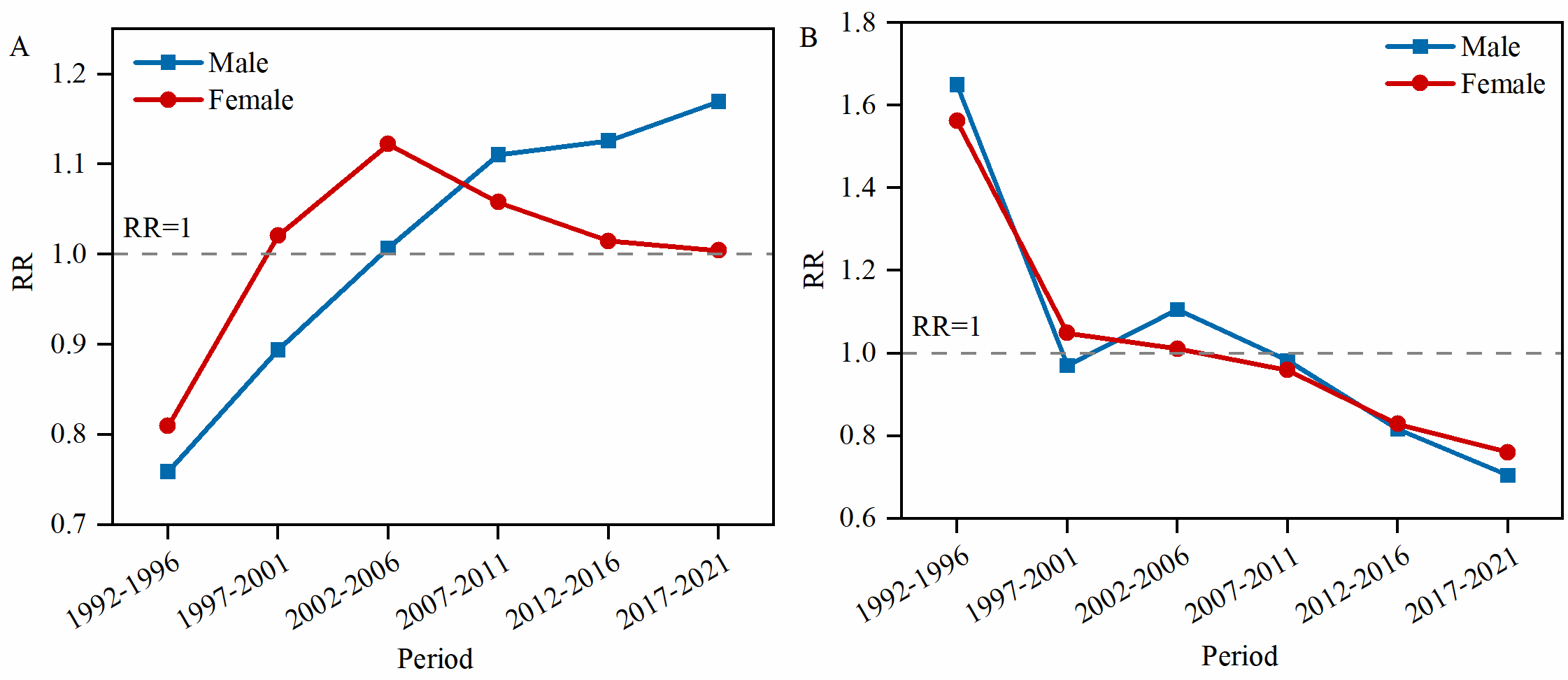
Figure 4: (A) Period effect of syphilis incidence in China from 1992 to 2021. (B) Period effect of syphilis mortality in China from 1992 to 2021
3.3.3 Birth cohort effect
The risk of syphilis in males and females decreased with the passage of birth cohort, and the risk of syphilis in males born from 1937 to 1941 was the highest (RR = 1.682, 95 % CI: 1.658-1.707), which was 68.2 % higher than the average risk. From 1977 to 1981, the incidence risk of birth population began to be lower than the average level (RR < 1). The risk was the lowest in 2012 ~ 2016 (RR = 0.531, 95%CI: 0.432 ~ 0.653). Women had the highest risk from 1932 to 1936 (RR=1.679,95 % CI: 1.610-1.752). From 1977 to 1981, the incidence risk of birth population began to be lower than the average level (RR < 1). The risk of syphilis was the lowest in the population born from 2007 to 2011 (RR=0.621,95 % CI: 0.603-0.639). See Figure 5A. The risk of syphilis death in males decreased with the birth cohort. The risk of death in the 1902-1906 birth cohort was the highest (RR=1.908), and the risk of death in the 1987-1991 birth cohort reached the lowest value. Most of the other birth cohorts were not statistically significant (P > 0.05). The risk of syphilis death in women showed a downward trend with the birth cohort, but the statistical significance was not significant (P > 0.05). See Figure 5B.
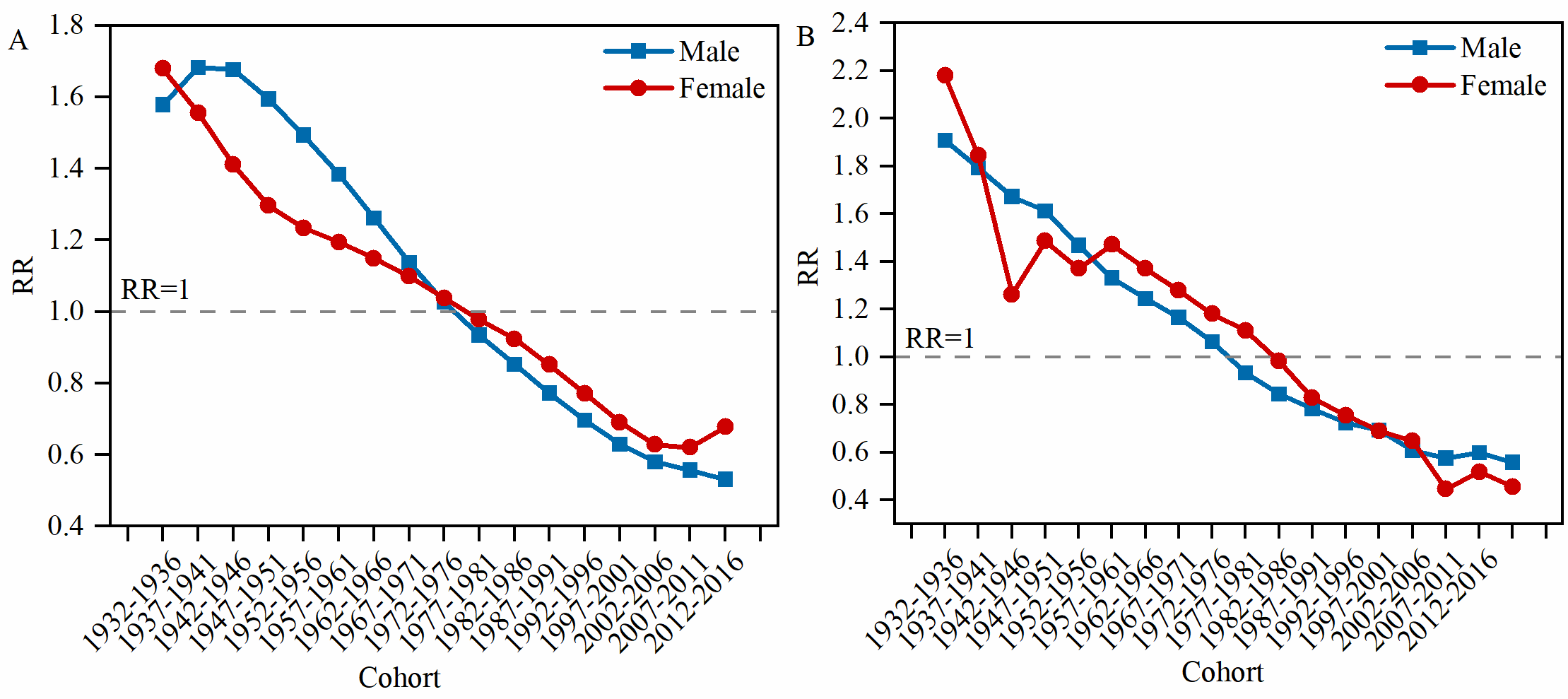
Figure 5 (A) Birth cohort effect of syphilis incidence in China from 1992 to 2021. (B) Birth cohort effect of syphilis mortality in China from 1992 to 2021.
3.4 Prediction of syphilis incidence and mortality in China from 2022 to 2046
3.4.1 Prediction of syphilis incidence
The prediction results of syphilis incidence are shown in Figure 6. The incidence and ASIR (Age-Standardized Incidence Rate) of the overall population, males, and females in China showed a downward trend. It is predicted that the total number of syphilis cases in China in 2046 will be 1,200,280, with 1,024,726 cases in males and 175,554 cases in females. The overall ASIR will be 121.82 per 100,000, 180.49 per 100,000 in males, and 35.91 per 100,000 in females.
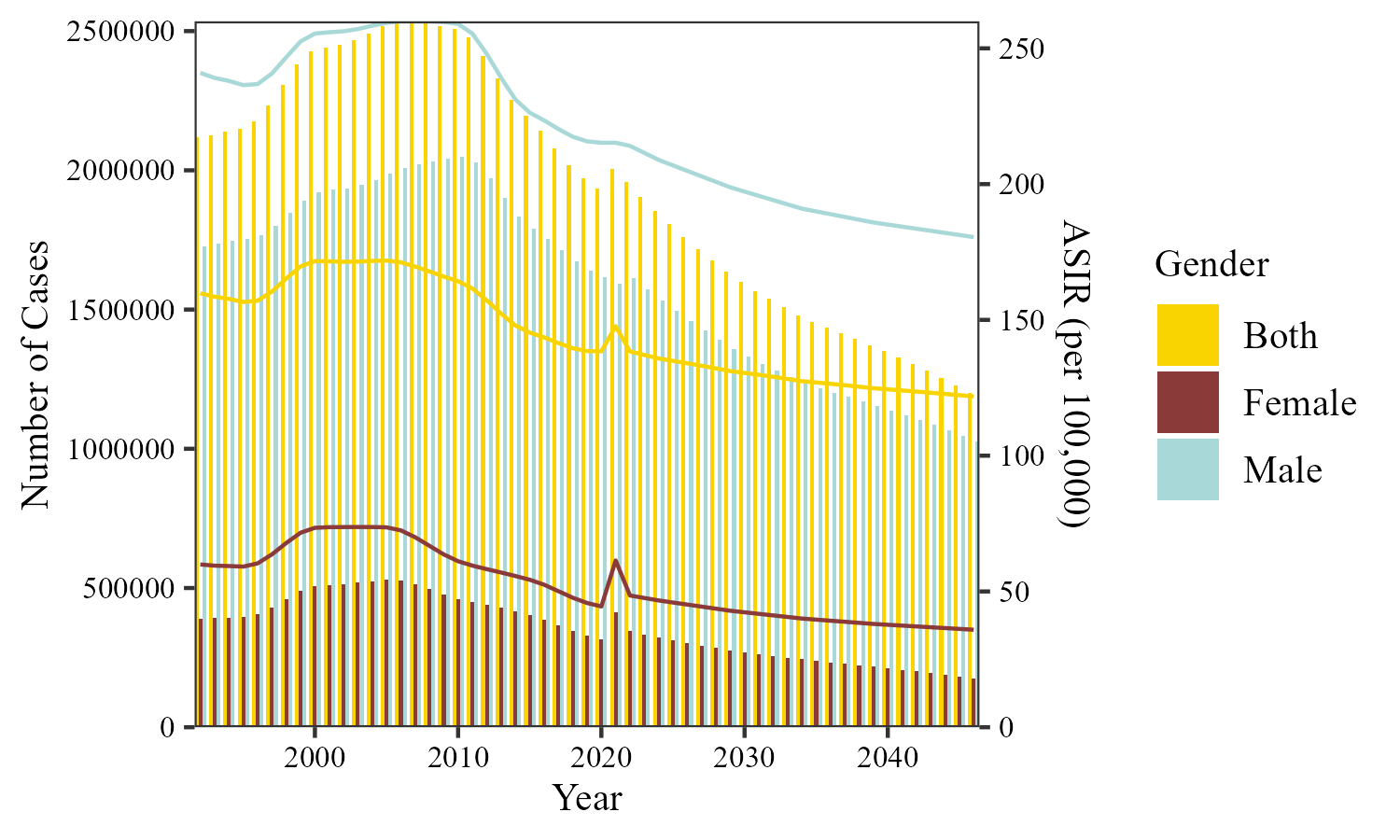
Figure 6: Prediction of syphilis incidence in China from 2022 to 2046
3.4.2 The Prediction of syphilis mortality
The prediction results of syphilis mortality are shown in Figure 7. From 2022 to 2046, the overall, male, and female deaths due to syphilis and the age-standardized mortality rates (ASMRs) in China showed a downward trend. It is predicted that the total number of syphilis-related deaths in China will be 799 by 2046, with 436 males and 363 females. The overall ASMR will be 0.13 per 100,000, 0.13 per 100,000 for males, and 0.14 per 100,000 for females.
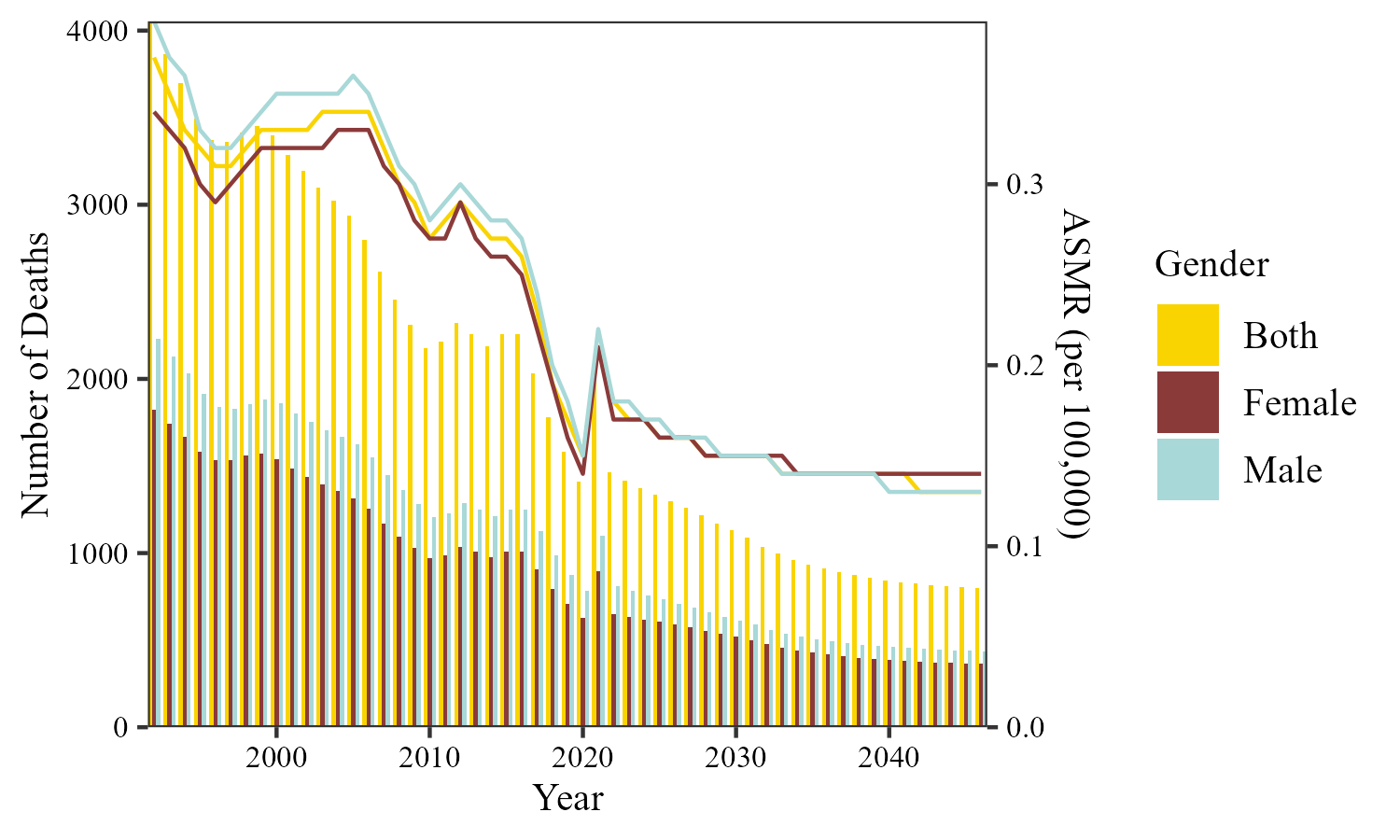
Figure 7: Prediction of syphilis death in China from 2022 to 2046
4. Discussion
Based on the data of GBD 2021 database, this study analyzed the incidence and mortality of syphilis in China from 1992 to 2021. The results showed that the incidence of syphilis in 2021 was 0.93 % higher than that in 1992. The main reason was the increase of population, rapid social development, transportation and economic development, population mobility, screening expansion and other comprehensive factors [17]. However, the incidence and ASIR decreased by 14.46 % and 0.95 %, respectively. The number of syphilis deaths, mortality and ASMR decreased by 51.22 %, 58.82 % and 12.50 %, respectively. Although the number of cases increased, ASIR and ASMR decreased after structural adjustment, suggesting that the prevention and control of syphilis in China has achieved good results in recent years. Especially since 2010, the government has taken a number of intervention measures, such as promoting sexual health education and publicity, cracking down on illegal sexual transactions, improving the STD prevention and control system, and providing free detection and treatment of syphilis, which have greatly reduced the spread of syphilis. The incidence, incidence rate, ASIR, mortality, crude mortality and ASMR of syphilis in men are significantly higher than those in women, which may be related to the fact that men are more exposed to gender-specific risk factors, such as male-male behavior, which increases the risk of male infection [18], neglects health problems, and has low medical compliance, which can easily lead to delayed diagnosis and advanced syphilis, and aggravate the risk of death. Therefore, at the level of disease prevention and control, it is necessary to carry out targeted health promotion of male syphilis, strengthen early screening and standardized treatment, and reduce the risk of death.
The results of the joint point regression analysis showed that the ASIR and ASMR of syphilis in China from 1992 to 2021 generally showed a trend of increasing first, then decreasing and then increasing. Among them, syphilis ASIR decreased the fastest from 2008 to 2019, which may be due to the introduction of China 's syphilis prevention and control plan (2010-2020) [19] and the implementation plan for the prevention of mother-to-child transmission of AIDS, syphilis and hepatitis B [20] in 2010 and 2011, which reduced the risk of syphilis transmission. From 2002 to 2019, syphilis ASMR showed a rapid downward trend, indicating that since the new century, people's quality of life has improved and medical technology has advanced, leading to a decrease in syphilis mortality. However, the ASIR and ASMR of syphilis in China showed an upward trend from 2019 to 2021. It may be due to the outbreak of COVID-19 in 2020. With medical attention shifted to the epidemic, the intervention services for sexually transmitted diseases were limited, and the screening and diagnosis rates of syphilis decreased, resulting in a large number of hidden infections that were not found and treated in a timely manner [21]. This is consistent with the findings of Liu M [22] on the epidemiological and clinical effects of the COVID-19 outbreak on syphilis, and those of Yan X [23] on the prevalence of sexually transmitted diseases in China affected by COVID-19. With the control of the epidemic in 2021, syphilis rebounded, resulting in an overall upward trend in 2019-2021. Syphilis still poses a continuing challenge to public health. In addition, the improvement of syphilis diagnosis and testing technology and the strengthening of syphilis screening have led to an increase in the incidence of syphilis [17]. In the future, it is still necessary to strengthen routine screening of syphilis to reduce the burden of syphilis disease.
The age effect of APC model showed that the risk of syphilis in China showed an inverted U-shaped distribution, and the risk of syphilis began to increase significantly from 15 to 19 years old, which was related to the gradual younger age of sexual behavior, immature sexual psychology and lack of knowledge of STD prevention and treatment [24] It is suggested that we should pay attention to the problem of syphilis infection in adolescents and improve the popularization and education of sexual knowledge among young students. Secondly, the peak risk of syphilis in men and women is 25-29 years old and 20-24 years old, respectively. The peak age of women is earlier than that of men, which is related to women having sexual contact slightly earlier, including the situation where women may start sexual activities earlier due to precocious development and are more likely to suffer from forced sexual assault [3]. The high risk of syphilis among men and women aged 15 - 49 years is consistent with the findings of NiedÅwiedzka-Stadnik M [25] on syphilis in Poland and Peng X [26] on syphilis in Beijing. It may be due to the good physical condition, high energy level and active sexual life of the population in this age group. They are a high-risk group for sexually transmitted diseases and are often prone to syphilis infection due to extramarital sexual contact and unsafe sexual behavior. At the same time, with the popularity of social networks, dangerous behaviors (casual sexual behavior, multiple sexual partners, drug use, etc.) have increased [27]. Therefore, young and middle-aged people with special clinical symptoms should be vigilant and tested for syphilis as soon as possible. At the same time, this study found that the risk of syphilis death gradually increased with age, and the risk of death was the highest at 90 ~ 94 years old. The elderly syphilis population had decreased body immunity, more basic metabolic diseases, and poor tolerance to treatment, which could lead to serious consequences, such as neurosyphilis (10 % ~ 30 % of advanced patients), cardiovascular syphilis (4 % ~ 9 % of advanced patients), etc. [28], multi-disease comorbidity [29], further aggravating the risk of syphilis death in the elderly.
The period effect shows that the risk of syphilis in Chinese men has been increasing over time, which may be related to physiological differences and male unhealthy lifestyles. Men who have sex with men (MSM) have a higher rate of syphilis infection [30]. MSM groups use social software to find sexual partners and are prone to high-risk sexual behaviors [31], thereby increasing the risk of syphilis transmission. Peeling [32] and Guo [33] found that the incidence of syphilis among MSM increased. The risk of sexually transmitted diseases increased first and then decreased with the passage of time. From 2007 to 2011, the risk of sexually transmitted diseases began to decline. In 2010, China issued the " China Syphilis Prevention and Control Plan (2010-2020) " to improve the screening rate and treatment rate of syphilis in pregnant women. The policy has achieved initial results. In this study, the overall risk of syphilis death in Chinese men and women showed a downward trend over time, which may be related to the improvement of residents ' health awareness and the progress of treatment technology.
Cohort effect shows that the risk of syphilis incidence and death in China shows a downward trend with the passage of birth cohort, that is, the later the birth cohort is, the lower the risk of syphilis incidence and death is. On the one hand, it is related to the improvement of people 's economic status, the good sex education of the new birth cohort, and the stronger health literacy and disease prevention awareness [34].On the other hand, it may be related to the development of medical technology and the gradual improvement of medical security system and better prognosis. The Nordpred model predicts that the number of syphilis cases, deaths, ASIR and ASMR in China will continue to decline from 2022 to 2046, which is related to China 's emphasis on and continuous development of syphilis prevention and control policies, good results, and the goal of curbing the rapid rise of syphilis [35].
5. Conclusions
The incidence and mortality of syphilis in China from 1992 to 2021 showed an upward-downward-upward trend, and it is predicted that the incidence and mortality of syphilis in China will continue to decline in the future. The risk of syphilis morbidity and mortality is affected by age, period, and birth cohort. It is recommended to implement precise prevention and control by population. For young men (especially MSM), free syphilis rapid detection should be provided through voluntary counseling clinics and STD clinics. Free syphilis self-test tools should be promoted in high-risk population gathering places such as bars to achieve early diagnosis and standardized treatment. The media should be used to publicize the harm of syphilis and improve the awareness of syphilis prevention and control and active detection. For the elderly population, syphilis is included in the annual physical examination routine project, syphilis screening is strengthened and the treatment effect is tracked to reduce the risk of late complications. Syphilis should be included in the items of hospitalization and preoperative examination to reduce missed diagnosis. At the same time, health education was carried out to improve the awareness of syphilis prevention and health behavior of the whole people, and reduce the burden of disease and the risk of death. There are some limitations in this study: the study does not include provincial and municipal geographic distribution data, and it is difficult to reveal the regional differences in the prevalence of syphilis. At the same time, there is a lack of relevant data on the sexual behavior characteristics of key populations such as MSM. Follow-up studies should focus on solving these problems and comprehensively analyze the burden of syphilis disease.
Author Contributions: Conceptualization, T.H.; methodology, M.L.; software, M.L.; validation, M.L.; formal analysis, M.L.; investigation, T.H.; writing—original draft preparation, M.L.; writing—review and editing, T.H.; supervision, T.H.; project administration, T.H.; funding acquisition, T.H. All authors have read and agreed to the published version of the manuscript.
Funding: This study received no funding.
Data Availability Statement: This study analyzed the publicly available dataset - the Global Burden of Disease 2021 (GBD 2021). This database was established by the Global burden of disease (GBD) project carried out by the Institute for Health Metrics and Evaluation at the University of Washington in the United States. The specific data can be obtained from the Global Health Data Exchange (GHDx), through the website with free access (http://ghdx.healthdata.org/gbd - results - tool).
Conflicts of Interest: The authors declare no conflicts of interest.